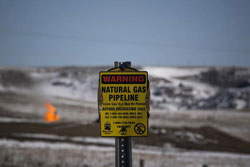Drilling at several natural gas wells in southwestern Pennsylvania released methane into the atmosphere at rates that were 100 to 1,000 times higher than federal regulators had estimated, new research shows.
Using a plane equipped to measure greenhouse gas emissions in the air, scientists found that drilling activities at seven well pads in the Marcellus Shale Formation emitted 34 grams of methane per second, on average. The Environmental Protection Agency (EPA) has estimated that such drilling releases between 0.04 grams and 0.30 grams of methane per second.
A study in the Proceedings of the National Academy of Sciences adds to a growing body of research suggesting that the EPA is seriously underestimating methane emissions from oil and gas operations. The agency is expected to issue its analysis of methane emissions from the oil and gas sector soon, which will give outside experts a chance to assess how well regulators understand the problem.
Carbon dioxide released by the combustion of fossil fuels is the biggest contributor to climate change, but methane – the chief component of natural gas – is 20 to 30 times more potent when it comes to trapping heat in the atmosphere. Methane emissions make up nine percent of the country’s greenhouse gas emissions and are on track to increase, according to the White House.
The Pennsylvania study was launched in an effort to understand whether the measurements of airborne methane matched emissions estimates based on readings taken at ground level, the approach the EPA and state regulators have used.
Researchers flew their plane about a kilometer above a 2,800 square kilometer area in southwestern Pennsylvania that included several active natural gas wells. Over two days in June 2012, they detected 2 to 14 grams of methane per second per square kilometer over the entire area. The EPA’s estimate for the area is 2.3 to 4.6 grams of methane per second per square kilometer.
Since their upper-end measurements were so much higher than the EPA’s estimates, the researchers attempted to follow the methane plumes back to their sources, said Paul Shepson, an atmospheric chemist at Purdue University who helped lead the study. In some cases, they were able to quantify emissions from individual wells.
The researchers determined that the wells leaking the most methane were in the drilling phase, a period that has not been known for high emissions. Experts thought that methane was more likely to be released during subsequent phases of production, including hydraulic fracturing, well completion or transport through pipelines.
The airborne readings were a snapshot over two days, Shepson cautioned, and further research over a longer period and at other sites are needed to know whether the Pennsylvania measurements are typical.
Much of the natural gas drilling in southwestern Pennsylvania goes through coal beds, which contain methane that might be leaking out, according to the study. The researchers speculated that underbalanced drilling methods – in which the pressure in the well-bore is lower than the surrounding geology – allows fluids and gases to enter the well-bore and travel to the surface. Energy producers use underbalanced drilling because it allows them to capture valuable supplies of ethane and butane, Shepson said.
The disparity between the researchers’ measurements and the EPA’s data illustrates the limits of the methods used by regulators, Shepson said. The EPA’s approach puts regulators at the mercy of energy companies, which control access to the wells, pipelines, processing plants and compressor stations where methane measurements should be made. “It’s tough,” Shepson said.
Last year, researchers from Stanford, Harvard and elsewhere reported in PNAS that methane emissions in the continental U.S. might be 50 percent higher than the EPA’s official estimates. Another study by Stanford researchers, published in February in the journal Science, also concluded that the EPA underestimates methane leakage from the natural gas industry and other sources.
The new study comes two weeks after the White House ordered the EPA to identify ways to cut methane from oil and gas production. If the agency decides to issue new rules they must be in place by the end of 2016.
In February, Colorado became the first state to regulate methane emissions from the oil and gas sector, requiring the industry to detect and fix leaks and install equipment to capture 95 percent of methane emissions. Recently, Ohio adopted rules to get companies to reduce methane leakage from above-ground equipment used in natural gas development, like valves and pipelines. Those rules do not appear to address leaks during drilling.
PHOTO TAKEN from csmonitor.com




